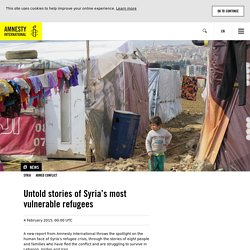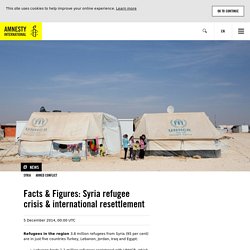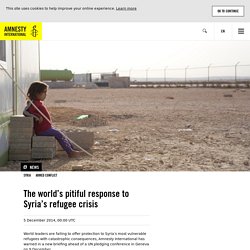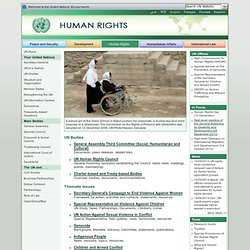

Social Studies teacher
Untold stories of Syria’s most vulnerable refugees. A new report from Amnesty International throws the spotlight on the human face of Syria’s refugee crisis, through the stories of eight people and families who have fled the conflict and are struggling to survive in Lebanon, Jordan and Iraq.

Hardship, Hope and Resettlement: Refugees from Syria tell their stories highlights the life-changing opportunity that international resettlement can offer to some of the most vulnerable refugees. Its publication marks the launch of Amnesty International’s #OpenToSyria campaign. The campaign aims to put pressure on wealthy countries, through public support, to accept a greater numbers of vulnerable refugees from Syria through resettlement and other humanitarian admission programmes.
So far, the international response to the crisis has been pitiful and some of the richest countries have done very little. “With close to 4 million refugees, the scale of the crisis is overwhelming. “World leaders cannot go on turning their backs on vulnerable refugees. Facts & Figures: Syria refugee crisis & international resettlement. Refugees in the region 3.8 million refugees from Syria (95 per cent) are in just five countries Turkey, Lebanon, Jordan, Iraq and Egypt: Lebanon hosts 1.1 million refugees registered with UNHCR, which amounts to around 26 per cent of the country’s population Jordan hosts 618,615 registered refugees, which amounts to 9.8 per cent of the populationTurkey hosts 1.6 million refugees, which amounts to 2.4 per cent of the populationIraq hosts 225,373 registered refugees, which amounts to 0.67 per cent of the populationEgypt 142,543 registered refugees, which amounts to 0.17 per cent of the population Conflict in Syria Around 190,000 people have been killed and 10.8 million people are in urgent need of humanitarian assistance inside Syria More than 10 million Syrians, or 45 per cent of the country’s population has been displaced Of those, 6.5 million are displaced within Syria and approximately 4 million have sought refuge in other countries.

International Resettlement Key facts: The world’s pitiful response to Syria’s refugee crisis. World leaders are failing to offer protection to Syria’s most vulnerable refugees with catastrophic consequences, Amnesty International has warned in a new briefing ahead of a UN pledging conference in Geneva on 9 December.

Left Out in the Cold: Syrian refugees abandoned by the international community highlights the pitiful numbers of resettlement places offered by the international community. Around 3.8 million refugees from are being hosted in five main countries within the region: Turkey, Lebanon, Jordan, Iraq and Egypt. Only 1.7 per cent of this number have been offered sanctuary by the rest of the world since the crisis began more than three years ago. The Gulf states– which include some of the world’s wealthiest countries – have not offered to take a single refugee from Syria so far. Russia and China have similarly failed to pledge a single resettlement place. “The shortfall in the number of resettlement places for refugees offered by the international community is truly shocking.
Teaching strategies. Global education covers complex and controversial issues.

This is a selection of teaching and learning approaches that develop knowledge and skills to respond to global issues. Freedom fighter or terrorist? Passionate or one-eyed? Passive resistance or civil uprising? Illegal arrival or asylum seeker? The words used and our interpretation of images and statistics are an insight into our perspective or bias – our view of the world. Global education aims to assist students to recognise bias in written and visual texts, consider different points of view and make judgements about how bias can lead to discrimination and inequality. Activities to help students understand bias: Younger students might rewrite a well-known story from a different perspective – for example, Little Red Riding Hood rewritten from the perspective of the wolf.
Cartoons are a great way to challenge thinking about an issue. Cartoons can be used in the global education classroom to: Activities Tell a story. The Universal Declaration of Human Rights. United Nations: Human Rights. A school girl at the Sitara School in Kabul pushes her classmate, a double-leg land-mine amputee in a wheelchair.

The Convention on the Rights of Persons with Disabilities was adopted on 13 December 2006. UN Photo/Hassan Zakizada UN Bodies General Assembly Third Committee (Social, Humanitarian and Cultural) Documents, press releases, related links. UN Human Rights Council General Assembly resolution establishing the Council, latest news, meetings, events, membership.
Thematic Issues Secretary-General's Campaign to End Violence Against Women Framework for action, activities and contacts, statements, resources. International Courts and Tribunals International Criminal Tribunal for the former Yugoslavia (ICTY) Overview, documents, latest news, courtrooms, cases, reports. Other Resources Universal Declaration of Human Rights The full text of the Declaration. Past Conferences. United Nations: Human Rights. Apartheid Explained.